|
|
|
There are over 35,000 villages in Rajasthan
with varying population of between 100 and 5,000 people, and 1,000 to
2,000 persons on an average. The village communities provide the basis for
all social life in Rural Rajasthan. This section will provide you
information about the lifestyle and social infrastructure of the rural
Rajasthan.
The colourful and picturesque costumes of Rajasthan reflect the people’s
joy of life and the desire to enliven their environment.
The men’s dress among the common people consists of a dhoti, an
untailored piece of cloth (about 4.5 metres X 4.5 metres), a bandia
angarkha or a full-sleeved, close-fitting, but buttonless vest and potia
or covering for the head. Among the well-to-do, the dhoti is a refined
handloom product with a coloured border. About the middle, the dhoti is
tied round the waist forming a waist-band. One of its ends passes between
the legs and is tucked in the waist-band behind, while the other is
gathered in pleats and tucked in at the navel.
On ceremonial occasions, the official class and the Rajput gentry use the
tight-fitting churidar pyjama, the kurta or a shirt (usually made of
muslin without collar or cuff) and either an achkan or a lamba angarkha
(long coat). The potia is replaced on such occasions by a turban, a
graceful and dignified headgear generally called pag, paga or pagri – a
fine piece
of cloth about 16.5 metres (18 yards) long and barely 0.2 metre (nine
inches) in width, embroidered at both ends and tied round the head in
various ways. Of the various styles of headgear current in Rajasthan, the
Marwari pagri or chonchdar pag, (beaked turban) deserves notice. The use
of a cotton or wool-len scarf round the neck or over the turban is also in
vogue.
Contact with Europeans in the last century brought into vogue the Jodhpuri
breeches. They represent a combination of riding breeches and military
overalls.
The dress of a Rajasthan woman consists of a ghagra of skirt, a kanchli of
half-sleeved bodice, an abbreviated blouse leaving the midriff uncovered,
and an orhni (mantle) which is about 2.2 metres (2˝ yards) in length. The
ghagra is a full skirt which may take as much as 36 metres (40 yards) of
cloth to make. The orhni is worn gracefully over the head and graped about
the entire figure.
Equally interesting is the traditional jewellery worn by Rajasthan woman
from head to foot. The anklets and heavy bracelets tinkle pleasantly with
the movement of the body. Intricately designed bangles adorn the arm.
Ivory bangles, white of tinted red, are worn by all married woman. Heavy
jhumkas (earrings) with inverted chhatri suspended like a bell at the
bottom decorate her ears, while kanthas or hasli of silver or gold
beautify the neck of a Rajasthan belle. The borla or sheesh phool, a round
boss, adorns the hair over the forehead and looks most attractive.
The pictorial art of Rajasthan, with is theme of love and devotion, is of
universal appeal. It reflects the emotional life of the people and has
kept close to their poetry, music, drama and religion. Spread over a long
span of time – 16th to 19th centuries – it has three distinct phases in
its development.
With a freshness and directness of treatment, appropriate to a young
movement, early Rajasthan painters broke away from the worn-out tradition
of the illuminated Jain manuscripts of 14th and 15th century Gujarat.
Their spiritual impulse came from the Vaishnava revival in the from of the
Krishna cult. Thus, the early Rajasthan paintings depict incidents from
the life of Lord Krishna. Scenes from the Ramayana and the Mahabharata,
the seasons (Baramasa), ballads and romantic poetry, are depicted with an
exuberant joy of life. A recurrent subject is the pictorial representation
of musical modes, the Ragmalas. The sentiment of love (sringar rasa) is
expressed throught Radha and Krishna typifying the eternal motif of Man
and Woman.
Rajasthan artists make use of brilliant colours rendered with tempere
effect. The women in Rajasthan miniatures are true to the Indian ideal of
feminine beauty-large lotus eyes, flowing tresses, firm breasts, slender
waist and rosy hands – and they reflect the heart of a Hindu woman with
all its devotion and emotional intensity.
By 1565, the Mughul school of miniature painting had established itself at
the court of Akbar the Great and begun to radiate its influence. The art
of Rajasthan was influenced by the technique of the court painters. Thus,
Rajasthan’s Ragmala paintings of 17th and 18th centuries show far greater
elegance in the treatment of the line and sophistication in colouring than
those of the earlier period. In the 18th century, Rajput chiefs began to
patronize art and their capitals, namely, Jaipur, Jodhpur, Bikaner,
Kishangarh, Bundi and Kotah became active centres of painting. New themes,
began to be attempted. Representations of durbar scenes, hunting
expeditions and royal processions, and portraits of the royalty and
nobility give some idea of the court life of those times.
With the disintegration of the Mughul empire towards the end of the 18th
century, the indigenous tradition reasserted itself in Rajasthan painting.
Freed from the imperial yoke, the Rajput princes built sumptuous palaces
and decorated them with frescoes whose themes were taken either from the
Puranic lore or from the life of the court. The paintings of this period
bear inscriptions on the reverse and sometimes on the margin. These
inscriptions give the name of the king or the grandee portrayed and often
the date of the painting and the name of the artist. Portraits of horses,
elephants and dogs are also attempted.
Rajasthan art spread far beyond the territory of the modern State of
Rajasthan. It found a congenial home in the hill-states of the Himalayas
in the north, Bundelkhand in the east and Gujarat in the south-west. One
of its offshoots, the Kangra School, grew into a vigorous art of great
beauty. Its creations combine the inspiration of Rajasthan art with the
technique of Mughul miniatures. |
|
Villages in Rural
Rajasthan |
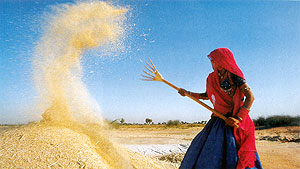 |
The villages are small communities which
are also known as the peasant society. In a defined geographical
area, a few dozen to hundred of families live in residential
clusters surrounded by agricultural and pasture land. Such villages
take their name from those of important deities, or of founder or
ancestor, or even on the basis of the area's geographical or social
characteristics. The villages can be spotted from highways to which
they are usually connected by narrow roads. From the distance, old,
large trees and cows, buffaloes, sheep, goats, camels, and other
domestic animals can be seen. Villages are often located near
village ponds or talabs that provide the source of water for cattle,
people and irrigation. Most of the houses in the villages are
connected to each other through a network of winding, kuchcha
lanes. |
|
The principal road, which may or may not be metallic, usually ends at some
central point of the village. The typical village home has a compound
marked by mud walls or tree branches, and is entered through a gateway
that leads to the open courtyard where men meet, and cattle may be seen.
The doors of the houses open on to the road, and on both sides of the door
there are small chabutras or platforms where people sit, children play,
and women discuss the day-to-day matters that affect their lives. Village
communities tend to live in joint families due to their work of
agricultural ploughing, irrigation, harvesting, selling. For organizing
weddings, death rituals, betrothal and other festive ceremonies, people
stay in touch, visit other villages, convey messages, and discuss daily
matters.
More.... |
|
|
People of Rural Rajasthan |
|
The villagers of
Rural Rajasthan are friendly and helpful, but wary of strangers. Men
and women never mix or talk in public except for business.
Amusements for the people are in plenty but are enjoyed in
segregated groups. In temples, small fortress, or at tea shops, the
people sit and exchange information, or merely pass time. On the
occasion of a baby’s arrival, a betrothal, or a wedding, women
gather in groups, dress beautifully and sing in a chorus for hours,
with the accompaniment of the dholak (small drum). Almost all
villagers in the rural Rajasthan are multi-caste. Traditionally,
there is one or few families of the Rajput caste who usually have
larger land holdings. They hold agriculture land and employ workers
from other caste groups.
|
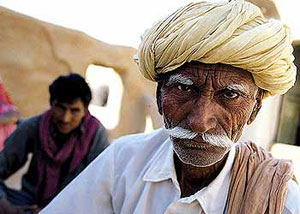 |
|
A few
Brahmin families in the village supervise ritual activities, work as
priests in temples, convey information about fasts and festivals,
and regulate the local calendar of festivals and social activities.
The priest chart the auspicious day and time for beginning a new
venture at home or in the field. The Brahmin priests are also the
village astrologers. Kumbhars make
earthen pots and serve the needs of their village. Carpenters are
required for making and maintaining agricultural implements. Various
craftsmen, puppeteers, singers, dancers, drum beaters, record-keepers,
dyers, printers and other serving caste are also there in the village.
Child marriages are quite common and mass marriages take place on
auspicious occasions. The brides and grooms are often toddlers, and ride
in a wedding procession on horseback or camelback under the watchful gaze
of guardians. |
|
|
Folk people or
Tribes of Rural Rajasthan |
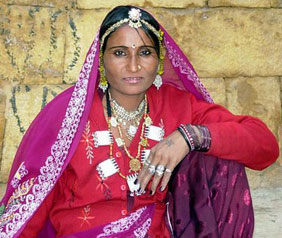 |
Nomads constitute about seven per cent of
the population of Rajasthan, and out of these, about one or two per
cent are non-pastoral or service nomads who comprise about two to
three hundred tribal groups with occupations like embroidery,
needlework, epic narrators, medicine sellers, fortune-tellers,
artisans, genealogists, dancers, singers, and hunters. Such nomads
visit villages in regular cycles to provide each community with their
services. Non-pastoral nomads offer more specialized goods and
services than any other culture area as in Rajasthan, villages are
located at greater distances from each other. At harvest time, various
nomads visit villages for providing important services. Members of
many families move to other villages or urban cities to earn a living.
The Rao-Bhats are family record keepers, and usually maintain the
records for a number of neighboring villages, on account of which they
need to travel frequently.
|
|
There are also mobile or gypsy castes who
inhabit villages for specific period of
time, providing a service while they camp
there. The Gadia Lohars, are ironsmiths who live and
travel in their own bullock carts, making and
mending iron implements for their
livelihood. The Kalbeliya families also move between
villages, camping in family groups wherever they stop for a few days. The Jats, Gujars, Yadavs and some other castes depend
entirely on agriculture. There are traditional caste families who work
on leather, weave cloth, grow vegetables, make ornaments, prepare
sweets, clean the village.
More.... |
|
|
Clothes
of People in Rural Rajasthan |
|
The colorful
head-wear (pugdi or turban) of men and the gaudy dresses of women
provide a wonderful contrast to the bleak environs of the state of
Rajasthan. In Rural Rajasthan, the rural women usually cover their
faces with a red or yellow colour odhni or dupatta and wear thick,
full-length ghaghara or skirt of the dark colour such as deep green
or dark blue with innumerable pleats and a blouse with colorful
designs. They adorn themselves with the heavy jewellery, earrings,
bracelets and rings made mainly of silver, which tinkles and jingles
when they grind grain, pound spices or draw water. The ornaments are
representative of certain social groups. The higher the caste group,
the lighter its use of dress (material and colours) and ornaments.
At the highest scale, fine fabrics and ornaments made of gold are
preferred. But in rural areas, silver ornaments are preferred. |
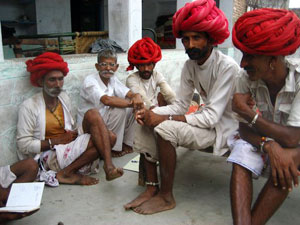 |
|
Silver
jewellery is usually heavier and uses
intricate, ethnic designs. Traditional
patterns are used for making necklaces,
earrings, bangles and anklets. Rings are
worn on fingers and on toes. A newly
married woman wear the boron on her head
all times, while the kankati or
waist-belt, and bangles of lac and glass
continue to enjoy vast patronage.
Weddings, the birth of children, and
festivals are great opportunities to find
women dressed in their finery. |
|
|
Music and Dance in Rural Rajasthan |
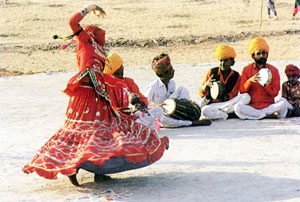 |
Music is the
lifeblood of village life in Rural Rajasthan. Songs are sung on
various occasions like childbirth, marriage, festivals, and during
their work in fields, or at home, when they take their cattle to the
pasture, or when they walk for long distances. Through music,
traditions are expressed and social systems are strengthened. No
festival is complete without music. Bhajans or devotional songs are
also sung. On various family rituals, neighbors and relatives are
invited to sing, especially at the time of Ratijaga, a ritual when
women have to stay awake through the night, singing songs devoted to
their ancestors and deities. Villagers also welcome and bid adieu to
their guests with songs. Dancing, too, is part of community culture
in Rural Rajasthan. In village life, group dances are preferred, and
men and women dance in separate groups.
|
|
In traditional
villages, the professional castes are
employed for the purpose of singing and
dancing for their patrons. One or more Dholi, the drum beater caste
is attached with a village. This family has rights and
obligations to serve the village with drum beating and singing. Mirasi,
Langa, Dadhi, Kalavant, Bhat, and Rao are various castes who sing, dance
and maintain family records of their patron castes. Some of the folk
musical instruments are often simple and even improvised from kitchen
utensils like the thali or metal platter, katori or metal bowls, cups,
fire tongs and the earthenware pot. The other instruments are jantar,
ravanhatha, tandoora, ektara, bhapang, kamaycha, while flutes, pungi-the
snake charmers' flutes, and dhols, dholaks, nagaras and changs (all drums)
are popular with folk musicians. Ravanahatta, a stringed instrument, is
played with a bow and is a forerunner of the western violin. Some of the
musicians roam villages singing songs about the adventures of ancient
Rajput heroes. These wandering minstrels are known as Bhats.
|
|
|
Religion in Rural Rajasthan |
|
In Rural
Rajasthan, each village has its own
deities (devtas) with shrines (devata
sthans) where the villagers go to pay
obeisance. In the summers, when most of
the land has a parched and barren look,
such religious spots are characterised by
a denser greenery and a small pond for
bathing, cooking and picnicking. These
spots also provide shelter for small
animals and birds. Most of the shrines are
located near the source of water since
cleansing of oneself is a necessary part
of the ritual of worship. Pathwari, the
goddess of the path, is found in almost
all villages in the form of a small
earthen or stone square structure which is
worshipped whenever a person undertakes a
pilgrimage. There are other mother
goddesses before whom the villagers pray
for shelter, nourishment and protection
from disease. The Bhairuji is a powerful
deity who looks after the interests of the
people of the village. Bhairuji's shrines
are rarely in the form of a temple, and
only a stone platform is there. Sagasji is
another local deity who offers protection
to harvests and animal life. Generally,
Sagasji is propitiated on the boundary of
a farm, or near an irrigation well.
Regional heroes such as Deo-Narayanji,
Gogaji, Tejaji and Ramdevji are worshipped
in villages. Some other gods which are
worshipped in the temples in Rural
Rajasthan include Lord Shiva, Krishna,
Ram, Lord Ganesh and other incarnations of
Vishnu. In villages where Muslim families
have their homes, a mosque or a roadside
shrine of Pir Baba can also be found. In a
cluster of villages, one deity is usually
more powerful or popular for a particular
power or authority. The shrines and trees
are not only protected, but also regarded
as sacred groves. |
|
Fairs and Festivals in Rural Rajasthan |
|
Fairs and festivals lend
vibrancy to village life in rural Rajasthan. A large number of fairs are
organized in rural areas, and the rural population gather in large number
to attend such fairs. Such fairs have a mixed commercial and religious
aspect. For example, in the Pushkar fair, cattle and camel trading is
combined with the annual pilgrimage to the Brahma temple and Pushkar lake
for ritual bathing and worship. Villagers use such opportunities for
buying the things they do not usually get in and around their villages. In
the local fairs, the villagers buy simple implements, tools, utensils and
jewellery. Women buy dresses, mirrors, utensils, printed bed sheets,
bangles and toys for children. Festivals are celebrated as family or
community events. During Gangaur festival in the month of Chaitra
(March-April),
|
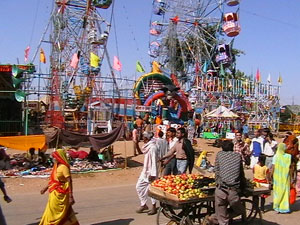 |
|
young unmarried
girls and those recently married visit
gardens in groups to bring flowers and
water pitchers and worship Gangaur or
Gauri Mata, the mother goddess, for being
blessed with an ideal husband, or for the
husband's well-being for about fifteen
days. Teej is celebrated in the rainy
season, a festival again for women, and
linked with marital celebrations. Amavasya,
the dark night, is considered inauspicious
by villagers who neither buy nor sell
anything on that day. Craftsmen, milkmen,
farmers and vegetable sellers do not work
on that day. On festivals such as Holi,
Diwali and Rakhi, rice and sweets are
cooked as consecrated offerings for the
gods. The tradition of telling stories on
those days when people observe fasts is
also popular in rural Rajasthan. During
such festivals, the women from the same
neighborhood tend to worship together, and
recount tales related with the fast.
Remembering myths and history is one way
of transmitting culture from one
generation to the next.
|
|
|
Cuisine of Rural Rajasthan |
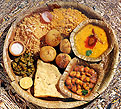 |
The cuisine of villagers in
Rural Rajasthan consists of one or two vegetables and rotis (breads)
on which ghee (clarified butter) is used. Rotis of wheat, maize, and
millets (bajra) are made. Rural cooking is a simple exercise, and
done by the women of the house. There are no sweet shops in the
Villages, and only milk and milk products like butter, buttermilk
and curds are consumed. Many communities are vegetarian, and in most
hamlets, these two frugal meals of Roti and Milk provide their basic
diet. Chai (tea) is prepared early in the morning, and in the
afternoon or evening, and whenever there are visitors. It is usually
strong, milky and very sweet. |
|
|
Industries in Rural Rajasthan |
|
In Rural Rajasthan, agriculture and allied
industrial sectors employ about 89.5% of the labour. Jowar and Bajra
are important food grains grown in Rajasthan. Some of the roads or
lanes are connected with the farms, and people are associated with
some form of agrarian activity. A few prosperous farmers have
substantial agricultural holdings to manage wells or canals. The
middle level agriculturists tend to work on their own farms, while
those whose holdings are small or not arable enough find
opportunities to work outside their farms. Tractors, threshers and
irrigation pumps have shortened the manual work of most men on their
lands. Most of the villagers now have enough electricity to run
irrigation pumps. Sheep grazing is a common sight, and sometimes
girls take up this job. Wool, dyeing and hand-painting are the main
industries. Bandhani prints are the main example. Today, with
improved means of transportation, fresh vegetables have arrived at
the doorstep of even the most remote village which was even not
possible a decade ago.
Infrastructure of Rural Rajasthan
Agricultural activity is looked after and helped by government
departments. The cooperative banks provide loans and new varieties
of seeds, chemical fertilizers, medicines and seedlings. Most of the
villagers now have enough electricity to run irrigation pumps. |
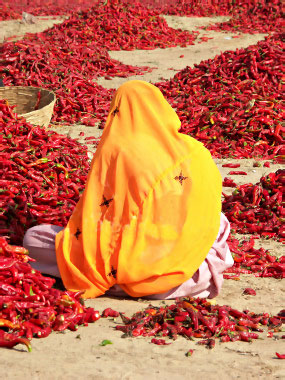 |
|
Drinking
water facilities have been created in
almost all villages. Dispensaries and
medicines are not far off from villages.
Roads have joined villages with towns, and
regular buses and other means of transport
are available. Television sets and radios
are providing the basis for more changes
in rural life. Telephonic communications
link the smallest village with the world
outside. Cinema and newspapers are
reaching across to them. But even as
changes are being brought about in their
lifestyles, the villages continue to be
the heart and soul of Rajasthan. |
|
|
Villages to Visit |
|
There are many villages in Rajasthan which can be visited. Some of these
villages are located in the Shekhawati region, around Jaisalmer, Udaipur
and Bikaner. The villages of Rajasthan are a classic way of exploring the
arduous life of Rajasthani folks who lives on the stubborn pulse of
nature. If you want to experience the true essence of Rajasthani village
life and that too from a close quarter, then you can stay in the rugged
huts of the village people and also enjoy their unique lifestyle with
delicious village cuisine.
More.... |
|
|
|
Rural
Rajasthan |
|
Villages in Rural Rajasthan
||
Villages to Visit in Rural
Rajasthan ||
Folk Tribes of Rural
Rajasthan ||
Arts of Rural Rajasthan
||
Art and craft of Rural
Rajasthan ||
Rural Rajasthan Tour
||
Rural Rajasthan Tour
Packages |
|